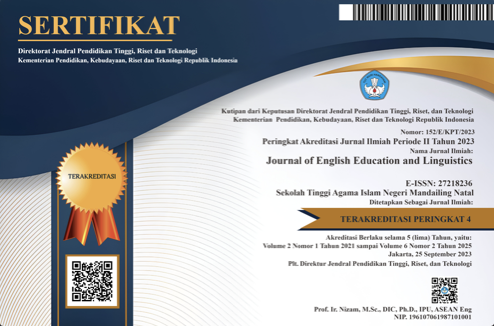COMPARISON OF WESTERN AND INDONESIAN GESTURES IN COMMUNICATION : SOCIOLINGUISTICS STUDY
SOCIOLINGUISTICS STUDY
DOI:
https://doi.org/10.56874/jeel.v2i1.400Keywords:
gesture, communication, culture, sociolinguisticsAbstract
Gestures serve different purposes in language. Nevertheless people find difficulties to learn and to understand the gestures due to the speakers of languages in certain cultures that use “gestures” can change the meaning or the meaning conveyed. This study deals with non-verbal communication strategies named gesture used in Indonesian and Western communication. The objectives of study are to describe the meaning of gestures and to find out the types of gestures used by Indonesian and Western people when communicating in Talk Show. This study applied descriptive qualitative method. The research instrument was video recorder. The data analysis showed that there were 5 types of symbolic movement, 11 types of illustrative movement, 7 types of emotion revealing movement , 3 types of modulation movement, 3 types of adaptable movement. The result of descriptive analysis showed that gestures have big roles in communication either in Indonesian and Western People. Some gestures have similar meaning both of cultures. However sometimes every country has their different meaning of gestures. Therefore, it is necessary to take care before using gestures in other cultures.
References
Broaders, S., Wagner Cook, S., Mitchell, Z., Goldin-Meadow, S. (2007). Making children gesture brings out implicit knowledge and leads to learning. Journal of Experimental Psychology. 136 – 4, 539-550.
Cao,N & Chen,G. (2017). The Role of Gesture in the Second Language Learning and Teaching. American Journal of Applied Sciences 2017, 14 (12).
Devito. J.A. (2002). Human Communication . Boston : Pearson.
Gullberg, M. (2013). Gesture Analysis in Second Language Acquisition. Oxford:
Blackwell Publishing.
Iriskhanova, O. K., & Cienki, A. (2018). The Semiotics of Gestures in Cognitive
Linguistics: Contribution and Challenges. Voprosy Kognitivnoy Lingvistiki, 4,
-36.
Kendon, A. (1984). Did gestures have the happiness to escape the curse at the confusion
of Babel? In A. Wolfgang (Ed), Nonverbal behaviour : Perspectives. Applications,
Intercultural Insights (pp. 75-114). Lewiston, New York: C. J. Hogrefe.
Kendon, Adam, 2004. Gesture – Visible Action as Utterance. Cambridge University
Press.
Lustig, M. W. & Koester, J. 2010. Intercultural Competence: Intercultural
communication across cultures. Sixth Edition; Boston, MA: Allyn & Bacon. McNeill, D. (2000). Language and Gesture. Cambridge : Cambridge University Press. Miles,M.B., Huberman, A.M. &Saldana, J. (2014).Qualitative data analysis: a methods
sourcebook (3rd ed.). CA: Sage.
Ozourcun, F. (2013). The Importance Of Body Language in Intercultural
Communications. EUL Journal of Social Sciences, IV (II), 70-81.
Sugirin. (2009). Cross-Cultural Understanding: what every efl teacher should know. Yogyakarta: Indonesia.
Pease. (1990). Body Language: How to Read Other’s Thoughts by Their Gestures. London : Sheldon Press London.
Verderber, R. F and K. S. Verderber. (1980). Inter-Act: Using Interpersonal Communication Skills. First Edition; Belmont, CA: Wadsworth.
Puspakirana, I., & Setiawan, S. (2014). A study of cross-cultural understanding of
showing anger in Indonesian and Australian families. Language Horizon, 2(2).
Sekine, K., Stam, G., Yoshioka, K., Tellier, M., & Capirci, O. (2015). Cross-linguistic
views of gesture usage. Vigo International Journal of Applied Linguistics VIAL,
(12), 91-105.
Downloads
Published
Issue
Section
License
All articles published in the Journal of English Education and Linguistics are licensed under a Creative Commons Attribution-ShareAlike 4.0 International (CC BY-SA) license. This means anyone is free to copy, transform, or redistribute articles for any lawful purpose in any medium, provided they give appropriate attribution to the original author(s) and Journal of English Education and Linguistics, link to the license, indicate if changes were made, and redistribute any derivative work under the same license.
Copyright on articles is retained by the respective author(s) without restrictions. A non-exclusive license is granted to the Journal of English Education and Linguistics to publish the article and identify itself as its original publisher, along with the commercial right to include the article in a hardcopy issue for sale to libraries and individuals.
Although the conditions of the Creative Commons Attribution-ShareAlike 4.0 International (CC BY-SA) license do not apply to authors (as the copyright holder of your article, you have no restrictions on your rights), by submitting to the Journal of English Education and Linguistics, authors recognize the rights of readers and must grant any third party the right to use their articles to the extent provided by the license.

This work is licensed under a Creative Commons Attribution-ShareAlike 4.0 International License.








